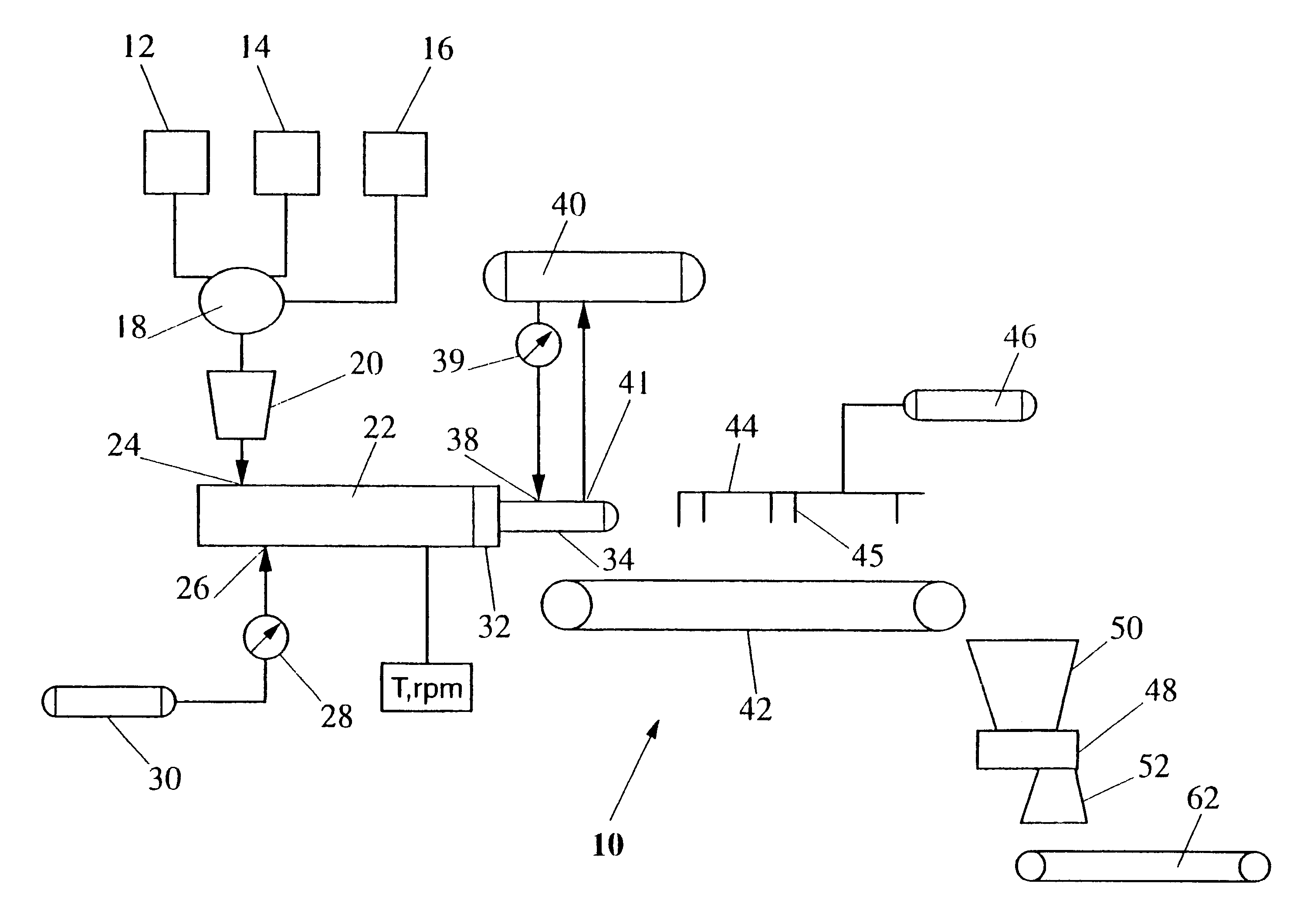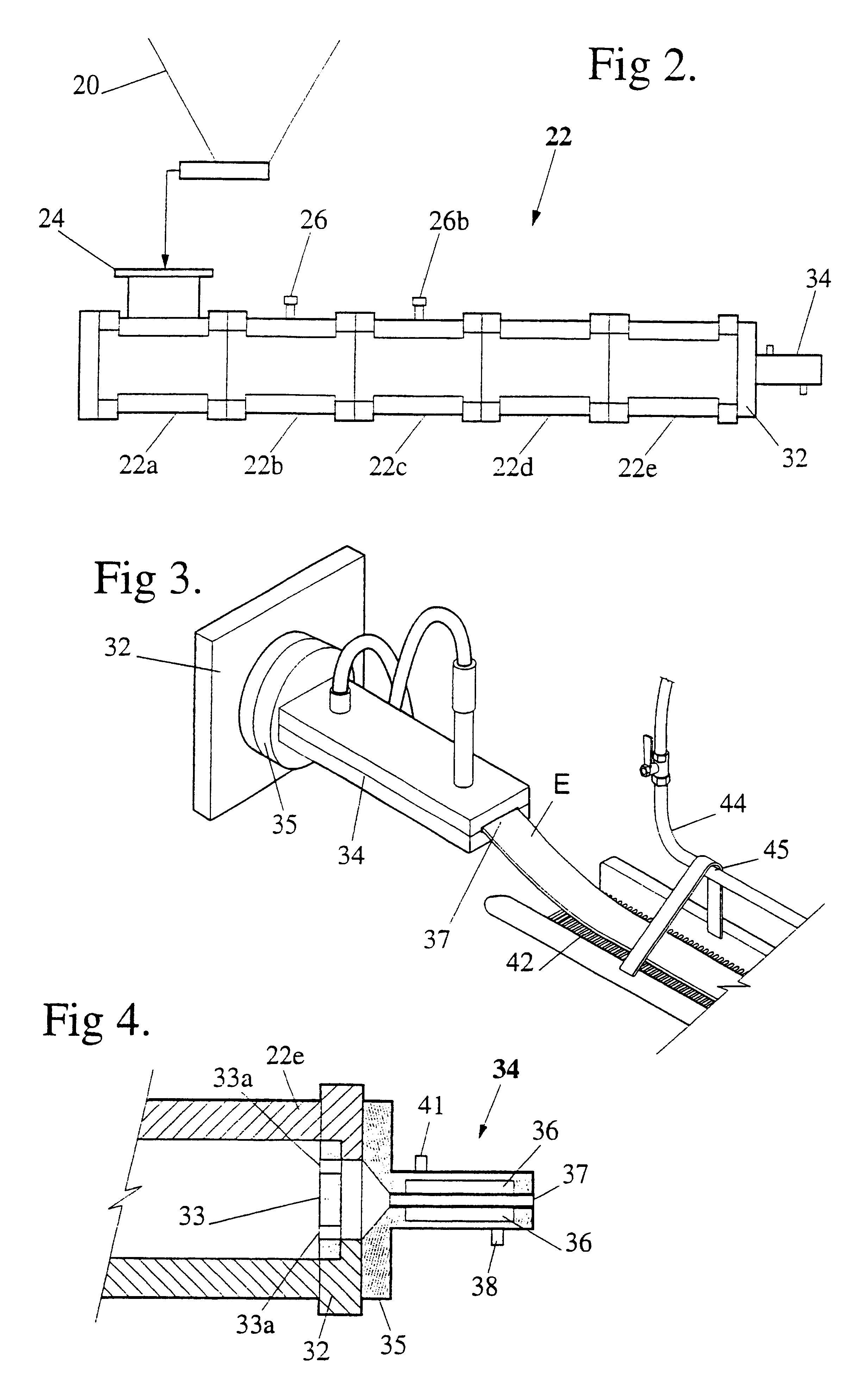Method and apparatus for the manufacture of meat
a technology of meat and apparatus, applied in the field of meat manufacturing methods and equipment, can solve the problems of not being meat-like at all, affecting the quality of meat products, and not being able to call meat analogues,
- Summary
- Abstract
- Description
- Claims
- Application Information
AI Technical Summary
Problems solved by technology
Method used
Image
Examples
example 1
A manufacturing process, using production line 10, for a desired meat analogue product using ingredients listed in Table 2 will now be described.
The ingredients are pre-blended in a weight range as indicated in Table 2 in ribbon blender 18 and metered into extruder 22 using mass dry material hopper 20. The moisture content of the dry ingredient blend is typically in the range 9-14% by weight. Water is metered into the first or second section of the extruder barrel through injection port 26. Steam may also be used, metered into the extruder's second or third barrel section.
The extruder screw(s) convey the moistened mixture toward the outlet at the last extruder barrel 22e, the mixture being hereby subjected to increasing shear and pressure. Temperature in the barrel sections is generally set between 60-140.degree. C., the higher temperatures being present at the middle barrel sections where plastification and "melting" of the dry precursor materials is mostly effected, whereas pressu...
example 2
A specific example of a meat analogue product manufactured in accordance with the invention and the process parameters used during its manufacture are provided below.
Meat analogue chunk having a fibrous striated structural matrix and resembling tuna white meat was prepared using the method and apparatus generally described above as follows:
The ingredients listed in Table 4 were weighed out as indicated there, milled through a hammer mill fitted with a screen of size 1.2-2 mm and pre-blended in a ribbon blender for 4 minutes.
The blended mixture was then fed into the hopper and metered into the extruder (Werner & Pfleiderer C58, fitted with 5 barrel sections) at a rate of 40 kg / hr. Water was added at the barrel section adjacent to the feed section at a rate of 32 kg / hr. The extruder screw rpm was set at 250. Temperatures of the barrels were regulated to the values listed in Table 5.
The dry precursor materials and water are plasticised and molten into a viscous extrudate as they are co...
example 3
Meat analogue chunk having a fibrous striated structural matrix and resembling beef muscle meat was prepared using the method and apparatus generally described above as follows:
The ingredients listed in Table 6 were weighed out as indicated there, milled through a hammer mill fitted with a screen of size 1.2-2 mm and pre-blended in a ribbon blender for 4 minutes.
The blended mixture was then fed into the hopper and metered into the extruder (Werner & Pfleiderer C58, fitted with 5 barrel sections) at a rate of 40 kg / hr. Emulsified beef liver was added at the barrel section adjacent to the feed section at a rate of 50 kg / hr. The extruder screw rpm set at 280. Temperatures of the barrels were regulated to the values listed in Table 7.
The dry precursor materials and meat are plasticised and molten into a viscous extrudate as they are conveyed through the extruder barrel sections. The hot melt is extruded through the breaker plate (20 holes with a diameter of 3.5 mm and land length of 10 ...
PUM
| Property | Measurement | Unit |
|---|---|---|
| Fraction | aaaaa | aaaaa |
| Fraction | aaaaa | aaaaa |
| Fraction | aaaaa | aaaaa |
Abstract
Description
Claims
Application Information
 Login to View More
Login to View More - R&D
- Intellectual Property
- Life Sciences
- Materials
- Tech Scout
- Unparalleled Data Quality
- Higher Quality Content
- 60% Fewer Hallucinations
Browse by: Latest US Patents, China's latest patents, Technical Efficacy Thesaurus, Application Domain, Technology Topic, Popular Technical Reports.
© 2025 PatSnap. All rights reserved.Legal|Privacy policy|Modern Slavery Act Transparency Statement|Sitemap|About US| Contact US: help@patsnap.com



